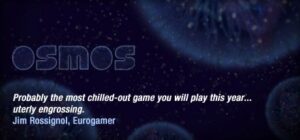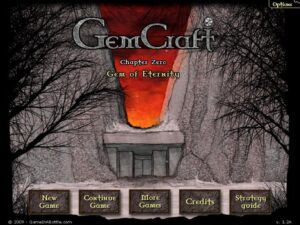Retro Replay Review
Gameplay
Starry Night refines the vertical‐scrolling space shooter into a gentle, almost meditative experience. Rather than piloting a heavily armed vessel, you guide a delicate bubble with your mouse cursor, using it to bounce a glowing yellow star upward. The simple click-and-drag mechanic belies a satisfying rhythm: timing each bounce to ensure the star touches as many burnt-out stars as possible rewards both precision and patience. Each successful contact illuminates the dark speck on the screen, while missed stars or letting the bouncing star slip off the bottom of the screen chips away at your health meter.
(HEY YOU!! We hope you enjoy! We try not to run ads. So basically, this is a very expensive hobby running this site. Please consider joining us for updates, forums, and more. Network w/ us to make some cash or friends while retro gaming, and you can win some free retro games for posting. Okay, carry on 👍)
The challenge ramps up naturally, introducing clusters of burnt-out stars in varied formations and staggered descent speeds. This encourages strategic positioning: should you aim for a tight cluster of three for a big bonus, or play it safe and illuminate one star at a time to preserve health? The replay value comes from chasing high-score combos—landing multiple illuminations in a single bounce feels wonderfully triumphant. With every cycle, the pace subtly quickens, pushing you toward ever-faster reactions without overwhelming the laid-back tone.
Controls are intuitive and responsive. Even newcomers to mouse-driven arcade puzzlers will find the learning curve gentle yet engaging. Tapping into the physics of rebound angles adds a layer of depth: you can bank the star off the edges of the screen to reach otherwise unreachable clusters. This mechanic becomes especially rewarding when you chain off two walls and still manage to light four stars in a single shot. The game’s balance between challenge and approachability makes each run a fresh, absorbing test of skill and foresight.
Bonus systems further enrich gameplay. Illuminating multiple stars with a single bounce multiplies your score and can trigger small visual flourishes—like a brief fireworks effect or an expanding halo of light—which not only gratify but also help you track your combo streak. The health meter, serving as both a punishment for mistakes and a soft timer, keeps the tension just high enough to stay engaged without breaking the game’s gentle flow. Overall, Starry Night offers a uniquely soothing, yet satisfying, arcade experience.
Graphics
At first glance, Starry Night’s visual style seems minimalistic, yet it captures a serene cosmic atmosphere. The background gradient shifts gradually through deep blues and purples, evoking an ever-changing sky at twilight. Each star—both the bouncing yellow orb and the dark, burnt-out targets—is crisply rendered with a soft outer glow that stands out against the vastness of space. The effect is like watching distant constellations suddenly flicker back to life under your care.
The animations are smooth and purposeful. The star’s rebound off the bubble or screen edges leaves a delicate trail of light particles, adding a sense of momentum and grace to every move. When you successfully illuminate a cluster, the explosion of light feels celebratory without ever feeling gaudy—perfectly in tune with the game’s calm pacing. Transitions between levels or score screens employ gentle fades, reinforcing the relaxing ambiance.
Subtle visual feedback keeps you aware of your performance. A shrinking health meter glows amber when you’re low on “lives,” and bursts into red when you’re on the edge of elimination—urgently reminding you to tighten your focus. On the audio-visual synergy side, the interface icons and score counters are clean, unobtrusive, and easy to read even during intense multi-star bounces. In sum, Starry Night’s graphics excel at marrying form and function in a way that’s both beautiful and helpful.
Story
While Starry Night does not present a traditional narrative with characters or cutscenes, it crafts a quiet story of celestial restoration. You assume the role of a cosmic custodian, tasked with reigniting dormant stars scattered across the heavens. There’s no dialogue or text logs; instead, the gradual illumination of the night sky becomes your unfolding tale—an implicit journey from darkness into light. This abstract narrative invites players to project their own meaning onto each session.
The minimalist story framework enhances immersion. By stripping away overt exposition, the game allows you to focus on the simple joys of discovery: watching a void transform into a constellation, patiently guiding a life-giving star to its target. Every newly lit star contributes to a larger tapestry, offering a quiet sense of progress that feels both personal and universal. The absence of intrusive lore means that each bounce and every combo becomes part of your own story.
Musical cues and ambient soundscapes further suggest narrative beats. Soft chimes play when you light a star, reinforcing the idea of rekindling hope in a silent cosmos. Slight swells in the background score correspond to combo streaks or level completions, hinting at moments of triumph without pulling you out of the experience. In this way, Starry Night tells its story through gameplay and sound rather than conventional plot devices.
Overall Experience
Starry Night stands out in the indie arcade scene by prioritizing calm, reflective gameplay over fast-paced aggression. Its soothing visuals, intuitive mechanics, and understated narrative combine to offer a uniquely restorative gaming session—ideal for both short, five-minute breaks and longer, score-chasing marathons. The game strikes a rare balance: it’s simultaneously accessible to casual players and engaging enough to satisfy those seeking depth and high-score mastery.
Technical performance is rock-solid. The game runs smoothly even on modest hardware, and load times are virtually nonexistent. The minimal system demands make it a great pick-up-and-play title for desktop setups or laptops. Additionally, its straightforward interface and mouse-only controls mean there’s no barrier for players unfamiliar with complex keybindings or controller setups.
Replayability hinges on the pursuit of personal bests and the joy of witnessing the night sky’s transformation. Each session invites you to push a little further, chase bigger combos, and stave off the creeping drain of the health meter. While some players might yearn for more varied environments or boss encounters, the game’s purity of concept is precisely what sets it apart. It reframes the shooter genre into something like a cosmic puzzle, where success is measured not in destruction, but in illumination.
Ultimately, Starry Night is a refreshing detour from high-octane action games. It’s perfect for anyone who loves arcade-style scoring, atmospheric presentation, and a gentle, almost zen-like challenge. Whether you’re in it for a quick zen moment or an all-night leaderboard grind, this title delivers an experience that’s both calming and compelling—like painting the sky star by star.
 Retro Replay Retro Replay gaming reviews, news, emulation, geek stuff and more!
Retro Replay Retro Replay gaming reviews, news, emulation, geek stuff and more!



Reviews
There are no reviews yet.